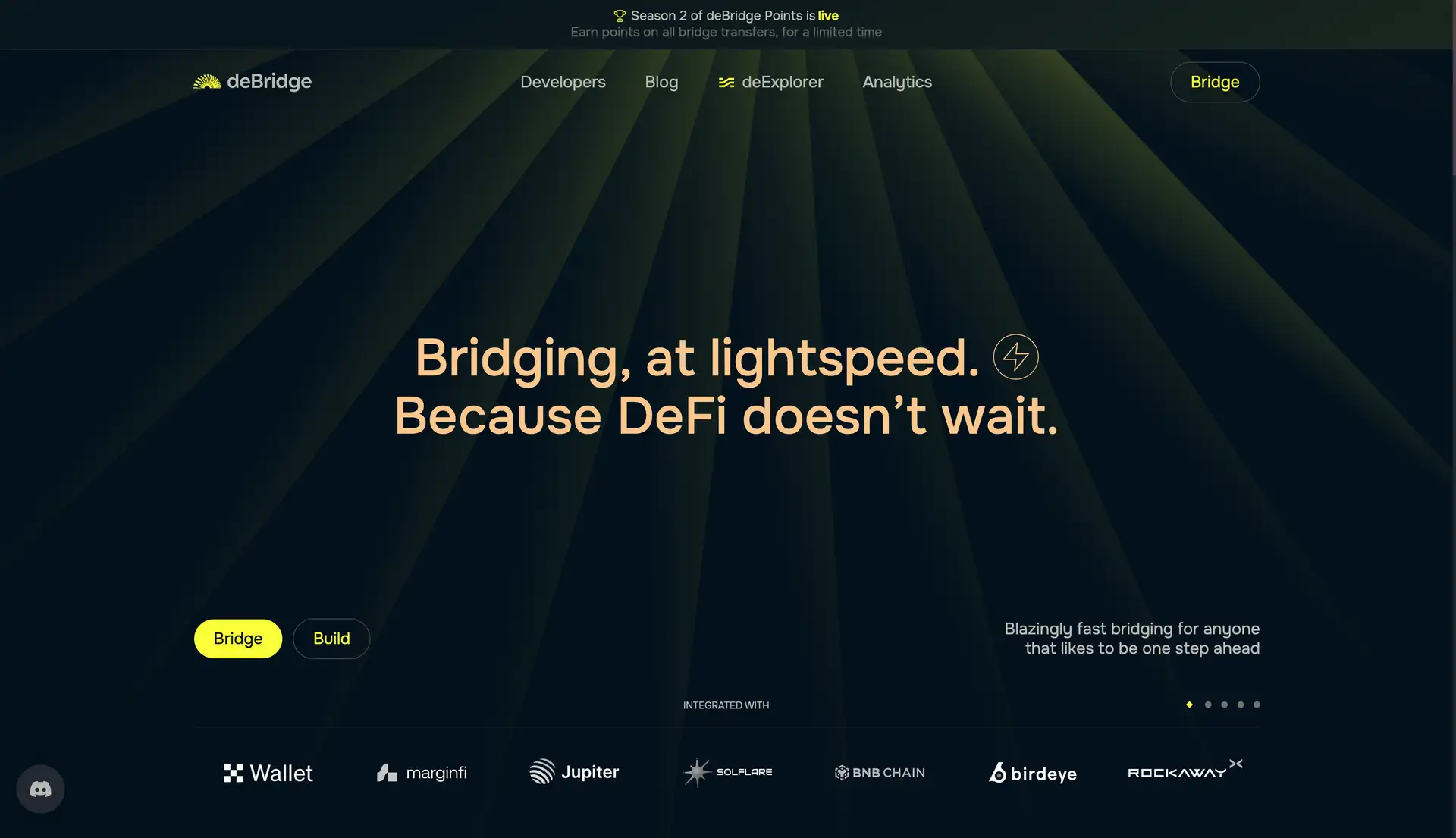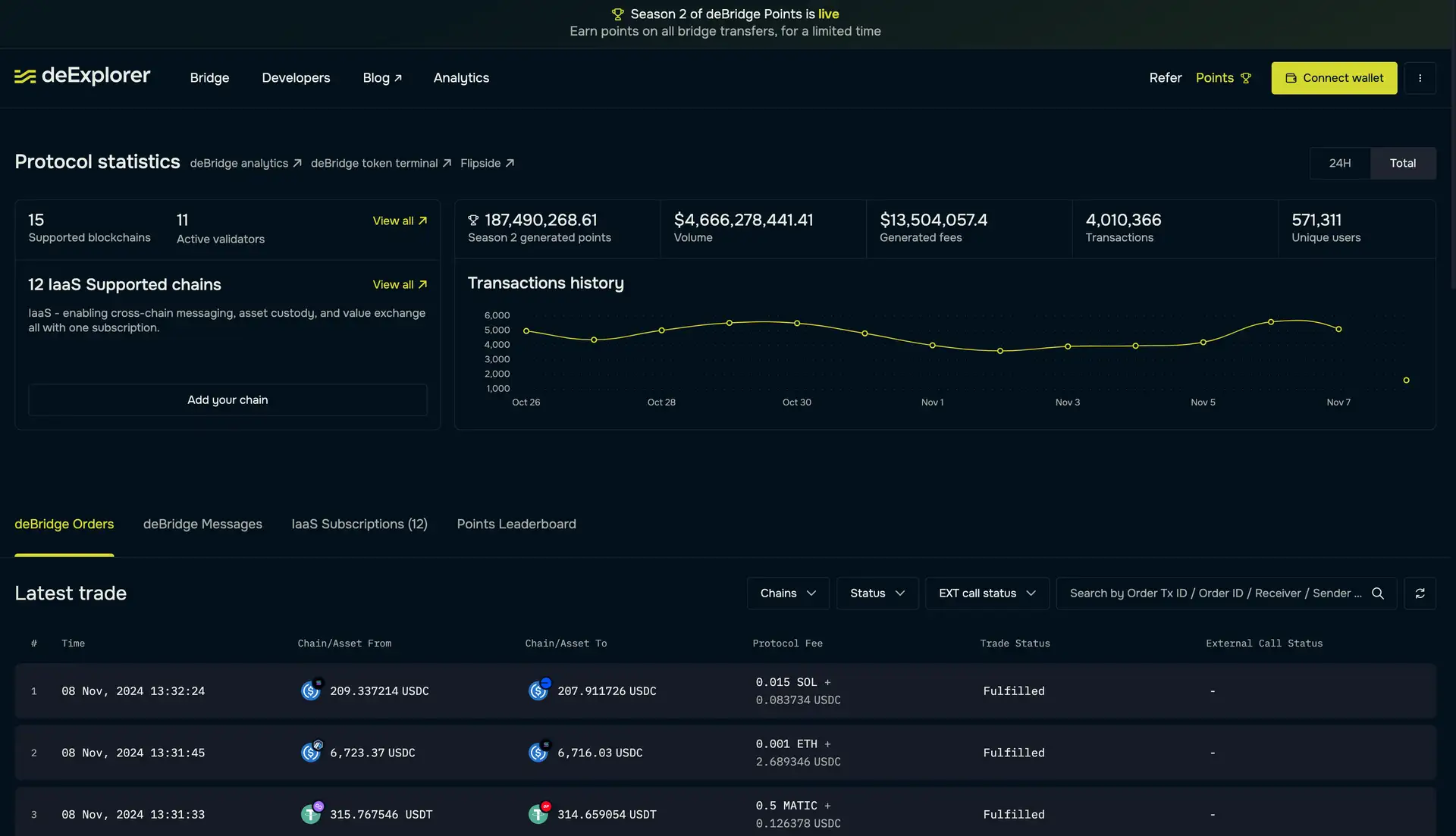About deBridge
DeBridge is a comprehensive cross-chain messaging protocol designed to eliminate silos within the blockchain ecosystem. By enabling seamless communication and asset transfers across various blockchain networks, DeBridge empowers developers and businesses to create applications that leverage the unique functionalities of multiple chains. This groundbreaking solution is vital for fostering innovation in decentralized finance (DeFi), NFTs, and broader Web3 applications.
The mission of DeBridge is to enable a more interconnected blockchain ecosystem, where projects can seamlessly access features and liquidity from multiple networks. By offering a decentralized infrastructure with a focus on security, scalability, and developer-friendly tools, DeBridge addresses critical challenges in blockchain interoperability.
DeBridge was founded to solve the critical challenge of interoperability in the blockchain space. With the increasing number of blockchain networks, each offering unique features, the lack of communication between them hinders innovation. DeBridge addresses this by providing a decentralized protocol for seamless cross-chain messaging and asset transfers.
A key feature of DeBridge is its use of decentralized validators to secure transactions. These validators collectively verify cross-chain activities, ensuring a high level of security without relying on centralized entities. The protocol is designed to be chain-agnostic, meaning it can integrate with any blockchain, offering unparalleled flexibility for developers.
Since its inception, DeBridge has achieved significant milestones. It has formed partnerships with leading DeFi projects, expanded its validator network, and integrated with major blockchains like Ethereum, Binance Smart Chain, and Solana. This extensive compatibility ensures developers can leverage DeBridge's infrastructure to build applications that span multiple ecosystems.
One of DeBridge's standout features is its ability to optimize liquidity across chains, a crucial requirement for DeFi projects. By enabling cross-chain liquidity transfers, DeBridge allows developers to enhance capital efficiency and unlock new use cases. Additionally, its modular design simplifies the integration of cross-chain functionalities, making it highly appealing to developers.
In a competitive landscape that includes projects like Polkadot, Cosmos, and Wormhole, DeBridge differentiates itself with its focus on decentralization, developer-friendly tools, and its ability to provide a highly secure and scalable infrastructure.
By bridging the gaps between isolated blockchain ecosystems, DeBridge is revolutionizing how blockchain networks interact. Explore its full range of features on the DeBridge website.
DeBridge provides numerous benefits and features, making it a leading solution in blockchain interoperability. Key advantages include:
- Cross-Chain Messaging: Seamlessly enables communication and data transfer across different blockchain networks.
- Decentralized Security: The platform uses decentralized validators, ensuring high levels of trust and security.
- Chain-Agnostic Compatibility: Integrates with any blockchain, offering maximum flexibility for developers.
- Developer-Friendly Tools: Provides robust SDKs and APIs that simplify cross-chain integration for dApps.
- Liquidity Optimization: Enables DeFi projects to access liquidity across multiple chains, enhancing capital efficiency.
- Scalable Infrastructure: Designed to support enterprise-level applications with high transaction volumes.
- Modular Architecture: Offers customizable solutions to meet specific project requirements.
Getting started with DeBridge is simple and user-friendly. Follow these steps to begin:
- Visit the Official Website: Start by visiting the DeBridge website to explore the platform and its resources.
- Access Documentation: Review the comprehensive developer documentation available on the website to understand the platform’s features and integration process.
- Set Up Your Wallet: Ensure you have a compatible wallet, such as MetaMask, connected to the desired blockchain network.
- Integrate the SDK: Developers can download and implement the DeBridge SDK to enable cross-chain functionalities in their dApps.
- Test Your Integration: Use testnets supported by DeBridge to validate your implementation before launching on mainnets.
- Deploy Your Application: Utilize the provided tools to deploy smart contracts and fully integrate cross-chain functionalities.
- Seek Support: Join the DeBridge community or contact the support team for assistance during the integration process.
deBridge FAQ
DeBridge ensures security by utilizing a decentralized network of validators. These validators collectively verify all cross-chain transactions, eliminating the risks associated with centralized systems. This approach minimizes vulnerabilities while maintaining high levels of trust.
Yes, developers can use the DeBridge SDK to integrate cross-chain functionalities into their applications. The SDK provides tools to enable seamless communication and interaction across various blockchain networks. Visit the DeBridge website for detailed documentation.
Decentralized validators play a crucial role in the DeBridge protocol by verifying and securing all cross-chain operations. They ensure the integrity and reliability of transactions without relying on centralized intermediaries, which enhances the overall trustworthiness of the system.
DeBridge optimizes cross-chain liquidity by enabling DeFi protocols to tap into liquidity pools across multiple blockchains. This feature improves capital efficiency and unlocks new possibilities for DeFi use cases. Check out the liquidity solutions on the DeBridge website.
DeBridge is chain-agnostic, meaning it is compatible with virtually any blockchain network. It currently supports major blockchains like Ethereum, Binance Smart Chain, Solana, and more. Explore the full list of supported chains on the DeBridge website.
You Might Also Like












